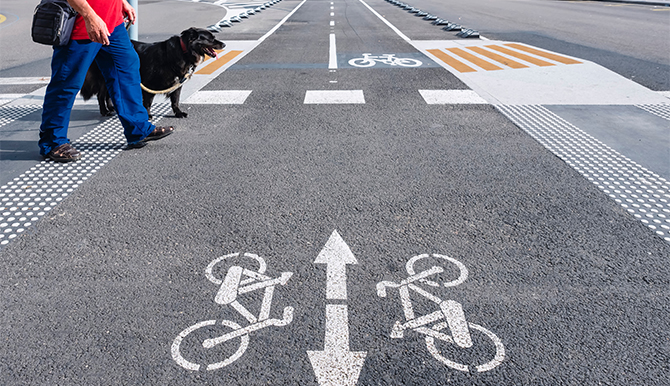PEOPLE with sight loss are finding it increasingly difficult to avoid accidents when walking around streets.
An increase in quiet vehicles like electric cars, bikes and e-scooters on streets are among their main concerns, says a new report from the Royal National Institute for Blind People (RNIB).
A lack of vital street landmarks such as detectable kerbs and pelican crossings are also making walking journeys increasingly risky.
Pavement parking, bins and overhanging shrubbery have always been a concern but now rental bikes and e-scooters are making things worse.
The easing of lockdown measures has also made independent travel more difficult, with many bars and cafes taking up vital pavement space which impacts on cane users and those with guide dogs.
Lindsay Coyle, RNIB regional campaigns manager, said: “We need everyone to understand how riding bikes or e-scooters on pavements and pedestrian spaces can be dangerous and intimidating for people with sight loss.
“Rental bikes and e-scooters left parked on pavements are a trip hazard which can cause injuries and damage confidence.
“Parking cars on pavements makes my life as a partially sighted person just plain difficult and bins left in the middle of the pavement after collection is also a major trip hazard which we can all help to avoid.”
The report’s key findings found:
- Four out of five blind and partially sighted people said walking journeys were their only, or main, form of outdoor physical exercise.
- A similar number said bikes affected their ability to make walking journeys, with many saying they had been run into.
- Cycling on pavements or other pedestrian spaces was specifically mentioned by just over one in three respondents.
- One in four specifically mentioned pavement parking as a barrier.
Lindsay Coyle added: “We need kerbs separating pedestrians from all vehicles including cycles and cycleways, and pelican and puffin crossings across roads and cycleways.
“We need local authorities, transport operators, designers and the Department of Transport to play a part and work with us to protect our pavements so everyone can use our streets independently.”
Seeing streets differently: How changes in our streets and vehicles are affecting the lives of blind and partially sighted people, click here
- Over two million people live with sight loss and this number is set to rise to four million by 2050.
- Instead of our streets becoming more accessible, they remain a daily obstacle course.
- RNIB Helpline on 0303 123 9999
—


